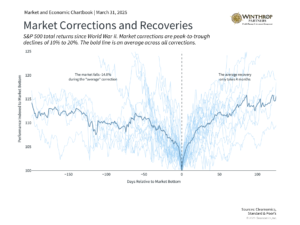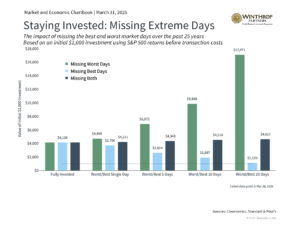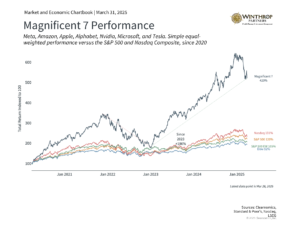Recent market turbulence driven by trade policy concerns has pushed major indices toward correction territory, leaving many investors wondering about market stability. The technology sector has been particularly affected by these developments, creating an environment that may feel like a recurring cycle of uncertainty. However, maintaining a long-term perspective during such periods is crucial for investment success.
Market cycles, much like natural seasons, include both periods of growth and decline. While market downturns can feel prolonged and difficult, history demonstrates that these phases eventually transition into periods of recovery and growth. Though current trade-related market volatility presents unique challenges, past patterns suggest that markets typically find their footing once uncertainty diminishes.
Historical data shows market corrections are temporary setbacks in long-term growth

Currently, the S&P 500 approaches correction levels, defined by a 10% decline from recent highs, while the Nasdaq has remained in correction territory for approximately four weeks.1 The uncertain economic environment has resulted in significant market fluctuations, with major indices experiencing daily swings of one to two percentage points.
A common market observation notes that prices tend to rise gradually but fall rapidly. This pattern reflects how bull markets typically develop slowly through steady gains, while negative catalysts often trigger sharp, sudden declines similar to recent events. However, it’s noteworthy that even after corrections, market bottoms tend to establish themselves above previous bull market peaks, illustrating the “up several floors, down one” nature of long-term market behavior.
This context is particularly relevant today, as the current S&P 500 correction references the all-time high from February. When viewed more broadly, current market levels approximate those from September of last year, helping to frame recent volatility in a wider perspective.
The chart illustrates that market corrections are regular occurrences, averaging 14.3% since World War II. Despite their frequency, markets have historically recovered within months, often rebounding when least anticipated. Recent examples include the recoveries following the pandemic in mid-2020, after the technology-driven bear market in late 2022, during the banking sector stress in early 2023, and numerous other instances.
Market timing strategies often lead to suboptimal investment outcomes

Market volatility often tempts investors to attempt timing their market exposure, seeking safety during downturns. However, such strategies frequently prove counterproductive, as investors commonly miss the initial stages of market recoveries. Additionally, waiting for clear signs of market recovery before reinvesting can significantly impact long-term returns. The accompanying chart demonstrates these effects by showing the impact of missing both extreme positive and negative market days over 25 years.
While avoiding market declines might seem appealing, accurately timing such moves proves extremely challenging, if not impossible. Even with perfect timing of extreme market days, the outcome only marginally improves upon a buy-and-hold strategy. Given that investors typically react to past events rather than anticipate future ones, maintaining a long-term investment approach typically yields better results than attempting to time market movements.
Technology sector volatility amid trade policy uncertainty

Investors continue to assess the various potential outcomes of current trade policies and tariff implementations. These measures often serve as negotiating tools for broader policy objectives, including immigration reform. Consumer sentiment and inflation expectations have already shown sensitivity to potential price increases, while significant escalation could theoretically impact global economic growth.
While current tariff implications remain unclear, their full economic impact typically develops gradually. It requires multiple quarters to understand how businesses adapt their supply chains, whether they absorb or pass along costs, and how trade partners implement reciprocal measures.
Recent market declines have been led by technology stocks, which previously drove market gains in recent years, as shown in the chart. The Magnificent 7 stocks’ recent volatility should be considered within the context of their substantial long-term appreciation, exemplifying the increased volatility characteristic of certain market segments.
Notably, several sectors have demonstrated resilience during recent market turbulence, including Energy, Healthcare, Utilities, and Financials. Despite recent volatility, eight of eleven S&P 500 sectors maintain positive performance over the past year, highlighting the benefits of broad market diversification within well-balanced portfolios aligned with long-term financial objectives.
The bottom line? While tariff-related concerns have intensified market volatility, particularly affecting technology stocks, historical evidence supports maintaining a long-term investment perspective to achieve financial objectives.
1S&P 500 declined 9.2% between February 19, 2025 and March 28, 2025. The Nasdaq fell 14.1%, between December 16, 2024 and March 28, 2025
Winthrop Partners is an SEC-registered investment adviser. Registration does not imply a certain level of skill or training. The information provided is for informational purposes only and should not be considered investment, legal, or tax advice. All investments carry risks, including the possible loss of principal. No advice or recommendations are being provided in this advertisement, and you should consult a qualified professional before making any financial decisions. Past performance is not indicative of future results.

Thomas Saunders is the Managing Partner of Winthrop Partners. Prior to founding Winthrop Partners, Tom was Senior Vice President at what is now JP Morgan. His career includes senior and executive roles at Brown Brothers Harriman and First Niagara Bank, a top 25 Bank. Click here to contact Thomas Saunders about your investment and planning requirements.

